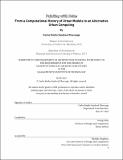Painting with data : from a computational history of urban models to an alternative urban computing
Author(s)
Sandoval Olascoaga, Carlos Emilio
DownloadFull printable version (23.63Mb)
Other Contributors
Massachusetts Institute of Technology. Department of Architecture.
Advisor
George Stiny.
Terms of use
Metadata
Show full item recordAbstract
The world is continuous: the number of elements acting upon cities is numerous, interconnected, and in constant transformation. In these terms, we can think of the city as a problem of organized complexity. As such, the city is inherently unpredictable. It operates through a careful combination of serendipity and habit. The success and survival of the city lies on its capacity to create opportunistic and unexpected connections, and transformations: serendipity beyond habit. Nevertheless, urban planning's relationship to policy-making has pushed their methods closer to those of science, establishing a need for empirical legitimization for decision-making. Historically, different fields have been brought into planning, importing their methodologies into urban models, but more importantly, military rhetoric and their mechanisms imbued the planning discipline over the last century. However, despite the large economic and social capital invested in the development of such tools during the 1960's, the results were overly simplistic, and did not provide new insights. Given the introduction of digital computers, and their increased computational capacity, urban models have slowly moved towards the quantitative disciplines of economics, and statistics, and away from design. Through a historical study of the mathematical and computational structures of thought that shaped contemporary urban planning tools, the thesis provides a framework for an alternative classification of such tools, not by their models' outputs, or the political conditions that led to them, but based on their computational origin. Their computational origin, as I argue, constrains, and defines their representations of the world, and the way in which the user explores the world. Based on the historical study, the thesis proposes a number of guidelines for the development of an alternative urban computing methodology. Painting with Data, an open-source web-application is proposed as a first step to constructing urban computing tools that are transparent, open-ended, collective, visual, and non-deterministic, considering the city as a problem of organized complexity. Painting with Data proposes an urban computing tool that moves beyond quantification mechanisms as the primary driver of urban modeling. Alternatively, this thesis proposes an iterative process between the world, its abstractions and representations, and the designer. In this sense, the representational models are generative: they provide a reflective interface that integrates personal perception, cognition, and notation. Painting with Data, utilizes voxels, a computer graphics technique, combined with a graph database as an alternative data representation. Its technological and theoretical features propose a hybrid approach to urban computing, combining functional and representational modeling to provide users with an agency in representation, an ability to compute visually, and to lower the barriers of entry to urban modeling through real-time user interaction. Such models can create intuitions of the relational structures among urban dynamics, providing personal and contextual transparency to the modeling process, and motivating civic engagement in policy-making.
Description
Thesis: S.M., Massachusetts Institute of Technology, Department of Architecture, 2016. This electronic version was submitted by the student author. The certified thesis is available in the Institute Archives and Special Collections. Cataloged from student-submitted PDF version of thesis. "June 2016." Includes bibliographical references (pages 207-214).
Date issued
2016Department
Massachusetts Institute of Technology. Department of ArchitecturePublisher
Massachusetts Institute of Technology
Keywords
Architecture.